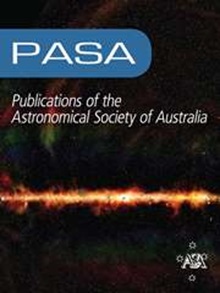帕克斯脉冲星定时阵列第三次数据发布
IF 4.6
3区 物理与天体物理
Q1 ASTRONOMY & ASTROPHYSICS
Publications of the Astronomical Society of Australia
Pub Date : 2023-06-28
DOI:10.1017/pasa.2023.36
引用次数: 35
摘要
摘要:本文介绍了帕克斯脉冲星定时阵列(PPTA)项目的第三次数据发布。该新闻稿包含了使用64米帕克斯“Murriyang”射电望远镜获得的32颗脉冲星的观测结果。数据跨度可达18年,典型的节奏为3周。此数据发布是通过将我们的第二个数据发布的更新版本与主要使用在704和4032 MHz之间运行的超宽带接收器系统获得的3年最新数据相结合而形成的。我们提供校准的脉冲轮廓,通量密度动态谱,脉冲到达时间和初始脉冲星定时模型。我们描述了处理这种宽带观测的方法,并将此数据发布与以前的发布进行了比较。本文章由计算机程序翻译,如有差异,请以英文原文为准。
The Parkes Pulsar Timing Array third data release
Abstract We present the third data release from the Parkes Pulsar Timing Array (PPTA) project. The release contains observations of 32 pulsars obtained using the 64-m Parkes ‘Murriyang’ radio telescope. The data span is up to 18 yr with a typical cadence of 3 weeks. This data release is formed by combining an updated version of our second data release with
$\sim$
3 yr of more recent data primarily obtained using an ultra-wide-bandwidth receiver system that operates between 704 and 4032 MHz. We provide calibrated pulse profiles, flux density dynamic spectra, pulse times of arrival, and initial pulsar timing models. We describe methods for processing such wide-bandwidth observations and compare this data release with our previous release.
求助全文
通过发布文献求助,成功后即可免费获取论文全文。
去求助
来源期刊
CiteScore
5.90
自引率
9.50%
发文量
41
审稿时长
>12 weeks
期刊介绍:
Publications of the Astronomical Society of Australia (PASA) publishes new and significant research in astronomy and astrophysics. PASA covers a wide range of topics within astronomy, including multi-wavelength observations, theoretical modelling, computational astronomy and visualisation. PASA also maintains its heritage of publishing results on southern hemisphere astronomy and on astronomy with Australian facilities.
PASA publishes research papers, review papers and special series on topical issues, making use of expert international reviewers and an experienced Editorial Board. As an electronic-only journal, PASA publishes paper by paper, ensuring a rapid publication rate. There are no page charges. PASA''s Editorial Board approve a certain number of papers per year to be published Open Access without a publication fee.

 求助内容:
求助内容: 应助结果提醒方式:
应助结果提醒方式:


